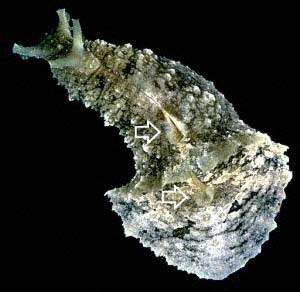
Dolabella auricularia
(Lightfoot, 1786)
Order: ANASPIDEA
Superfamily: APLYSIOIDEA
Family: Aplysiidae
PHOTO
UPPER RIGHT: Touaourou, S of Yaté, New Caledonia, October 1988, in seagrass beds, juvenile, 40mm long extended. Arrows showing position of inhalant (upper) and exhalant (lower) siphons into mantle cavity.
LOWER LEFT: Koumac, New Caledonia, 12m, silty bottom with dense gorgonian beds, October 1993, 124mm long alive.
LOWER RIGHT: Koumac, 1m, in seagrass beds, New Caledonia, October 1993, 105mm long alive.
PHOTOS: Bill Rudman.
Dolabella auricularia is a Sea Hare with a rather different shape than species of Aplysia. In Dolabella the back, or posterior end of the body is a sloping disc-like shield, with papillae around the edge and one large exhalant siphon in the middle. Buried in the tissue of this "back shield" is a large flattened, quite heavily calcified shell. In the midline, in front of the shield is a smaller groove which houses the inhalant siphon which draws water in to the almost totally enclosed mantle cavity. In the top photo the arrows show the locality of these two siphons.
Dolabella is quite variable in colour but it is always mottled shades of green and brown which make it extremely well camouflaged in nature. It is normally found in sheltered bays or lagoons, in grass beds or on sand or mud. It can also be found in large intertidal rockpools. Sometimes the only way you know it around is when you stand on it and it releases the tell-tale reddish purple aplysiid "ink". It feeds on a variety of brown green and red macroalgae and Pennings et al (1993) suggest that Dolabella actively maintains a mixed diet in preference to feeding on a single species of algae.
I have listed some references on various aspects of the biology, physiology and natural history of Dolabella separately.
See Dolabella auricularia shell page.
Compare with Dolabella gigas.
See Sea Hare shell page.
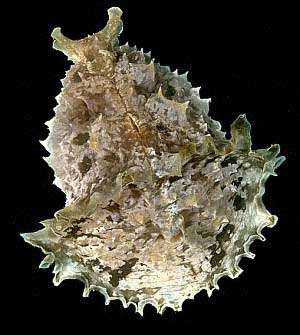
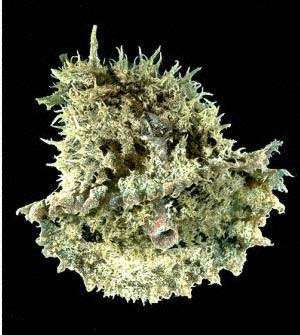
Rudman, W.B., 1999 (April 1) Dolabella auricularia (Lightfoot, 1786). [In] Sea Slug Forum. Australian Museum, Sydney. Available from http://www.seaslugforum.net/find/dolaauri
Related messages
Re: Suitability of Dolabella auricularia in an aquarium
March 8, 2010
From: Jorgen Svard
Concerning message #11612:
I have couple of questions. Do they tolerate watertemperature on 16-17°c. I wonder because I have a tank with an octopus with lots of algae. Also wonder if they are toxic?
Regards
Jorgen
Sweden
0521.66804@telia.com
Svard, J., 2010 (Mar 8) Re: Suitability of Dolabella auricularia in an aquarium. [Message in] Sea Slug Forum. Australian Museum, Sydney. Available from http://www.seaslugforum.net/find/23292Dear Jorgen,
As I indicated in the earlier message it is difficult to know just what will happen in an aquarium situation. Dolabella is unlikely to cause problems in an aquarium and if it likes your algae then perhaps all will be well. However the octopus may decide the Dolabella is worth eating. If so you could have a problem. I would suggest some grazing snails as a way of controlling your algae but I am afraid the octopus would almost certainly try and eat the snails.
I am afraid I am not an expert on aquarium 'ecosystems' so am very hesitant to give advice on the topic
You don't mention whether the other life in your tank is Swedish or exotic. If it is locally collected then my advice would be to try other local animals - but again the octopus - although a fascinating animal to keep in an aquarium - will not be very nice to other occupants of your aquarium.
Best wishes,
Bill Rudman
Dolabella auricularia diet
November 16, 2009
From: Keith Teller
Hello,
Are there alternatives to filamentous green hair algae when feeding Dolabella auricularia?
Has anyone had success with Nori? Lettuce?
Thank you for your input.
KT
ktellerman@aol.com
teller, K., 2009 (Nov 16) Dolabella auricularia diet. [Message in] Sea Slug Forum. Australian Museum, Sydney. Available from http://www.seaslugforum.net/find/22782Dear Keith,
I have heard of aquarists using garden lettuce to feed Sea Hares. Apparently if you quickly blanch it - that is dip it into boiling water for a few seconds, it softens the cell walls enough. Worth a try. But in all such activities only put small amounts in the aquarium or you will have a rotting waste problem.
As to the real food of D. auricularia, it feeds on a variety of red, brown and green algae. Have a look at the two scientific papers below for details. Both are available as pdf s from Steve Pennings home page
http://www.bchs.uh.edu/~steve/
- Pennings, S.C., Nadeau, M.T. & Paul, V.J. (1993): Selectivity and growth of the generalist herbivore Dolabella auricularia feeding upon complementary resources. Ecology, 74(3), 879-890.
- Pennings, S.C. & Paul, V.J. (1992): Effect of plant toughness, calcification, and chemistry on herbivory by Dolabella auricularia. Ecology. 73(5), 1606-1619.
Best wishes,
Bill Rudman
Re: Dolabella auricularia from Tonga
October 13, 2009
From: Alastair Robertson

Hi Bill
I took these photos in Tonga in June on Fafa Island. I would appreciate a confirmation of species Id if possible. I think the first shot shows mating - at least the two sea hares were linked somehow together
Alastair Robertson
kiwibiologist@gmail.com
Robertson, A., 2009 (Oct 13) Re: Dolabella auricularia from Tonga. [Message in] Sea Slug Forum. Australian Museum, Sydney. Available from http://www.seaslugforum.net/find/22701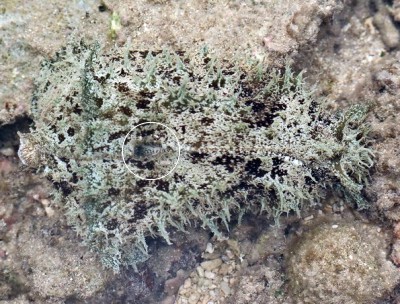
Dear Alastair,
This is the sea hare Dolabella auricularia. If you look at the messages attached to the species Fact Sheet you wll find quite a lot of information about this species. If you go to the General Topics list you will find a whole section on Sea Hares.
It's quite likely the two were mating. Like all opisthobranchs, Sea Hares are hermaphrodite, but in Sea Hares the penis is on the right side of the head, quite separate from the female genital opening which is much further back on the body. In your second photo I have ringed the inhalent opening into the mantle cavity which allows fresh seawater in over the gills. The common genital opening is just inside the inhalent opening. If you look carefully there is a groove running forward towards the head which carries sperm forward to the penis which opens on the right side of the head. So the position your animals are in fits with mating. For more on the topic have a look at the page on mating chains
Best wishes,
Bill Rudman
Re: Marine Spaghetti from the Philippines
September 25, 2009
From: Lorraine M. Cueva
Concerning message #17301:
Hi
Many families in the coastal regions in Visayas and Mindanao islands of Philippines use these eggs for food, and this is slowly growing popularity in different areas of the country.
As I very recently learned about people making a living out of sea slug eggs, I was concerned as to its effects in the reproduction of the species. Are there any significant effects of this human activity to their reproduction?
thank you in advance.
Lorraine M Cueva
weyn13@gmail.com
Cueva, L.M., 2009 (Sep 25) Re: Marine Spaghetti from the Philippines. [Message in] Sea Slug Forum. Australian Museum, Sydney. Available from http://www.seaslugforum.net/find/22667Dear Lorraine,
Sea hares such as Dolabella auricularia produce many more eggs than are needed to maintain their population levels so unless human egg gatherers are extremely efficient, I suspect enough larvae will survive to produce the next generation. However that is just a guess. To be sure you would need to do a proper scientific study over a number of years to see if Sea Hare and egg mass numbers increased, decreased or remained stable. Have a look at an earlier reply I gave [message #8577] to a question on the ecology of this species in the Philippines for some relevant references. Unfortunately, over-fishing or over harvesting is a major problem worldwide.
Best wishes,
Bill Rudman
Unknown from Camden Haven, New South Wales
January 9, 2009
From: Samson Kwok
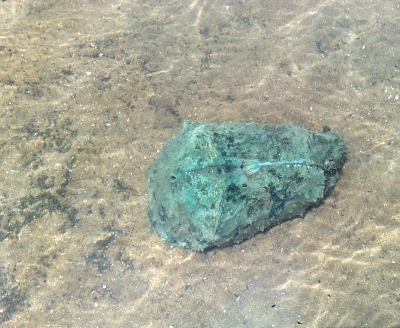
I have no idea of it! Appreciate if someone can identify that unknown creature for me! I wonder if it is a toxic shell-less creature laying on the Camden Haven lagoon?
Locality: Camden Haven Lagoon, New South Wales, 7 Jan 2009, on a muddy beach. Length: 200 mm. Photographer: Samson Kwok.
Samson Kwok
samsonkwok@live.com.au
Kwok, S.F., 2009 (Jan 9) Unknown from Camden Haven, New South Wales. [Message in] Sea Slug Forum. Australian Museum, Sydney. Available from http://www.seaslugforum.net/find/22138
Dear Sam,
This is a species of Sea Hare called Dolabella auricularia. If you look at the species' Fact Sheet you will find information and links to information on its biology and on Sea Hares in general. Also have a look at the earlier messages attached at the end of the Fact Sheet. If you want to open all the messages together, go to the bottom of the list of messages and click on Show factsheet and all related messages
Best wishes,
Bill Rudman
Dolabella auricularia from Mozambique
April 14, 2008
From: Valda Fraser
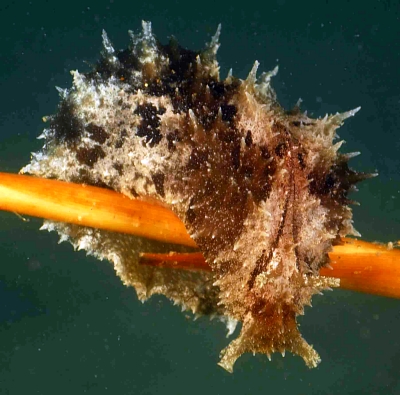
Dear Bill
I was fascinated by the Dolabella auricularia that graze in the estuary at Pomene where I love to spend some time.
Took so many pictures of them, but they looked just awful - blobs with little definition. Fortunately I found some small ones crawling about on sticks. These photos were much more successful. Thought I would share them with you.
Locality: Pomene, 2 m, Mozambique, Indian Ocean, 18 February 2008, Estuary. Length: 10 cm. Photographer: Valda Fraser.
Regards
Valda
valdafraser@mweb.co.za
Fraser, V.J., 2008 (Apr 14) Dolabella auricularia from Mozambique. [Message in] Sea Slug Forum. Australian Museum, Sydney. Available from http://www.seaslugforum.net/find/21503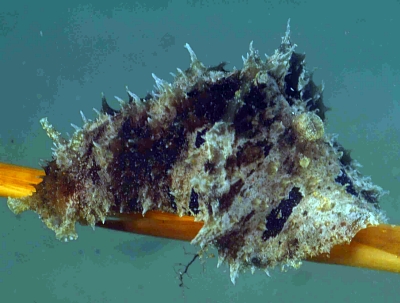
Dear Valda,
I must say Sea Hares are not usually objects of great beauty, but certainly the juveniles are usually better looking than their parents. Whenever I get a message about Dolabella from the western Indian Ocean I think of Dolabella gigas. As I said in a reply to an earlier message of yours [#4362], that species is an on-going puzzle. I suspect what we will need to do - or rather what someone in your part of the world will need to do - is to take the shell out of some likely suspects, because at present we have no real idea what the animal looks like alive.
Best wishes,
Bill Rudman
Sea hare from Port Hacking, Sydney
April 7, 2008
From: David Robertson
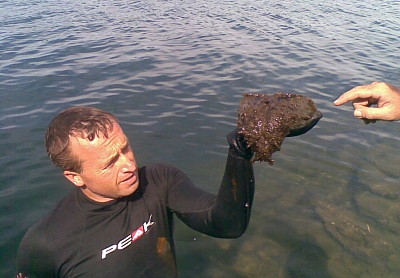
G'day,
I found this beastie in Burraneer Bay and am interested in learning it's identity. It inked when I disturbed it so I guess it is a sea hare of some sort.
Locality: Burraneer Bay, Port Hacking, Sydney, 1 m, NSW, Australia, 03 April 2008. Length: 200 mm
Regards,
David Robertson
daverobbo99@gmail.com
Robertson, D., 2008 (Apr 7) Sea hare from Port Hacking, Sydney. [Message in] Sea Slug Forum. Australian Museum, Sydney. Available from http://www.seaslugforum.net/find/21495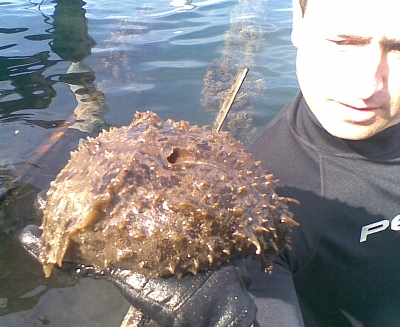
Dear David,
Yes this is the sea hare, Dolabella auricularia. If you have a look at the species' Fact Sheet and at the attached mesages you will find quite a bit on this species. It is found throughout the tropical Indo-West Pacific region and at times - like now- can be found in the more temperate waters of New South Wales. At 200 mm your animal is reaching the upper size limit of the species.
Best wishes,
Bill Rudman
Dolabella from South Africa
August 16, 2006
From: Waldo Nell
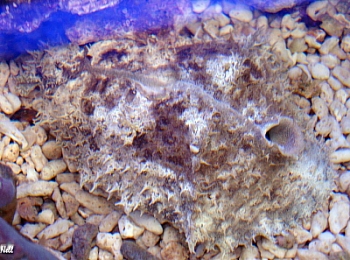
I have taken some quick snapshots of this sea slug at the LFS - sorry for the pathetic image quality but it was a small hand held camera and I was in a rush.
Can anyone ID this sea slug?
Waldo Nell
pwnell@telkomsa.net
Nell, W., 2006 (Aug 16) Dolabella from South Africa. [Message in] Sea Slug Forum. Australian Museum, Sydney. Available from http://www.seaslugforum.net/find/17439Dear Waldo,
This is the sea hare, Dolabella auricularia
Best wishes,
Bill Rudman
Re: Lukot - Marine Spaghetti from the Philippines
August 3, 2006
From: Richard Parker
Concerning message #17296:
Many thanks, Bill for this answer, which has relieved me somewhat - I thought it was a much more basic secretion than that.
But that has led to another speculation:
Apparently the colour of the eggs can change according to the type of algae the sea hare has eaten recently, and can also contain toxins derived from the algae, so I'll be checking the colour is ok before I eat any more of it, and hoping the local harvesters do the same.
Filipinos eat such sea food raw, as 'kinilaw' which is 'cooked' in vinegar, and sliced onions, ginger and chili are added.
see: http://www.coconutstudio.com/kinilaw_art.htm
Could the vinegar or spices de-nature some of the toxins that such foods could contain? I note that it's also recommended as a remedy for jellyfish stings. If so, then it's a very good example of the kind of 'folk wisdom' that's fast getting forgotten.
regards
Richard Parker
richardparker01@yahoo.com
Parker, R., 2006 (Aug 3) Re: Lukot - Marine Spaghetti from the Philippines. [Message in] Sea Slug Forum. Australian Museum, Sydney. Available from http://www.seaslugforum.net/find/17301Dear Richard,
It certainly seems that the colour of the eggs that a sea hare produces can change within 48 hours of a change in algal diet. However there is good evidence to show that secondary metabolites present in the algae [which include the distasteful, and/or noxious chemicals], are NOT transferred to the egg masses by the sea hares. This leaves the puzzle of why Sea Hare eggs are seldom, if ever, eaten by other animals. Laboratory experiments with fish and crabs show quite clearly that they reject the eggs as food. Whatever deters them doesn't seem to come from the algae, so there doesn't seem to be much point in checking the egg colour before you eat them.
Concerning the efficacy of vinegar as a home remedy for toxins and stings. All I am willing to say is that I live in Sydney where every year surfers and swimmers are regularly stung by bluebottles - the local name for Physalia - and other unidentified stingers. And every year there is a debate over whether vinegar, methylated spirits, ice, hot water, rubbing sand or even soluble aspirin on the affected skin, etc is the best cure for these stings. All I can say is the pain goes away eventually, even though new 'experts' with 'new cures' never do.
Best wishes,
Bill Rudman
Lukot - Marine Spaghetti from the Philippines
August 1, 2006
From: Richard Parker
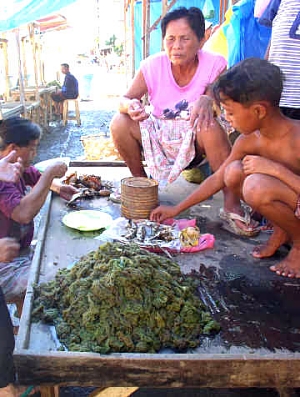
Lukot [Dongsul - Marine Spaghetti] is a marine delicacy sold in many Filipino restaurants. It's delicious and looks exactly like green spaghetti, and I have been told it is the 'secretions' of a seaslug (Aplysia ).
I have included it in my webpage on 'Seaweeds as Food" at:
www.coconutstudio.com/Philippinecaviare.htm
Locality: Siargao Island, Philippines, Pacific, Visayan Sea
Could someone please advise what kind of 'secretions' they are, so that I could put my squeamish thoughts to rest?
regards
Richard Parker
richardparker01@yahoo.com
Parkere, R., 2006 (Aug 1) Lukot - Marine Spaghetti from the Philippines. [Message in] Sea Slug Forum. Australian Museum, Sydney. Available from http://www.seaslugforum.net/find/17296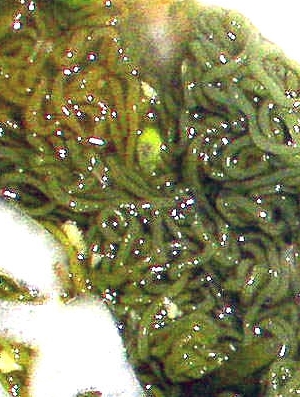
Dear Richard,
The 'spaghetti' is the egg string of a sea hare. If you look at Nerissa Bontia's earlier message [# 3047] I think we can pretty sure the animal producing the eggs is Dolabella auricularia. If you look closely at the close up photo you can see the individual eggs in the egg string. Have a look at the earlier messages on the D. auricularia page for further discussion
If you want further information on Sea Hares have a look at the General Topics list where there is a whole section on these animals.
Best wishes,
Bill Rudman
Is Dolabella auricularia hermaphrodite?
July 10, 2006
From: Gary Majchrzak
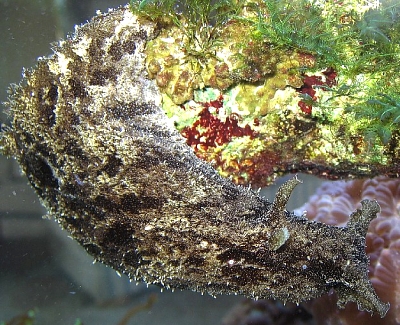
Hello, Bill.
Great forum you have. I have some questions regarding the Sea Hare I'm sending you pictures of. It's an aquarium specimen and about 5 inches long. I don't know where it was collected. It appears to be a Dolabella type Sea Hare, but I'm not sure.
Are these Sea Hares hermaphrodites? If not, is there a way to tell their gender?
Thanks for your time.
Sincerely,
Gary Majchrzak
garym@rochester.rr.com
Majchrzak, Gary, 2006 (Jul 10) Is Dolabella auricularia hermaphrodite?. [Message in] Sea Slug Forum. Australian Museum, Sydney. Available from http://www.seaslugforum.net/find/17079
Dear Gary,
Yes it is the Sea Hare Dolabella auricularia. Like all sea slugs they are hermaphrodite. As a consequence of this, sea hares often forming mating chains of 3 or more animals where the ones in the middle are acting as males and females simultaneously
Best wishes,
Bill Rudman
Dolabella auricularia from Forster, NSW.
March 23, 2006
From: Colin Malakou
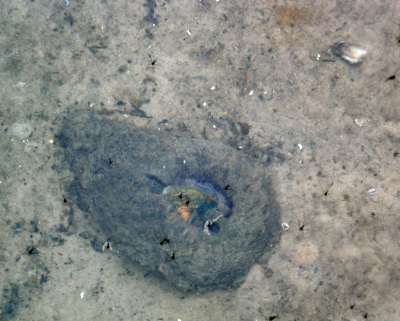
Whatsitsname? emits a red dye/blood when touched
Locality: Forster, nthn New South Wales, Australia, Depth: 1 ft. 21/22 March 2006, sand/slip. Length: under 30cm. Photographer: Colin.
Colin Malakou
coliin@bigpond.com
Malakou. C., 2006 (Mar 23) Dolabella auricularia from Forster, NSW.. [Message in] Sea Slug Forum. Australian Museum, Sydney. Available from http://www.seaslugforum.net/find/16161
Dear Colin,
Your animal is Dolabella auricularia. It is a Sea Hare, many of which produce a reddish or purple ink when disturbed. Your animal looks like it has been damaged because I can see part of its shell sticking out of its back. In this animal the shell is a flattened spiral, usually hidden in the skin [see D. auricularia shell Fact Sheet ]. If you look around the Forum you will find quite a bit of information on the Sea Hares.
Best wishes,
Bill Rudman
Re: Is my sea hare sick?
July 19, 2005
From: Brian Vastag
Thanks for your answer [#14278]. Very interesting! It started to display its penis a few hours after I fed it nori (dried seaweed). Could it be that the seaweed didn't agree with it? Any other possible explanations?
Brian Vastag
brianvastag@comcast.net
Vastag, B., 2005 (Jul 19) Re: Is my sea hare sick?. [Message in] Sea Slug Forum. Australian Museum, Sydney. Available from http://www.seaslugforum.net/find/14279Dear Brian,
I have no idea. It's recent traumas - from sea, to shop, to you (and nori) - have probably not helped its peace of mind.
Best wishes,
Bill Rudman
Is my sea hare sick?
July 18, 2005
From: Brian Vastag
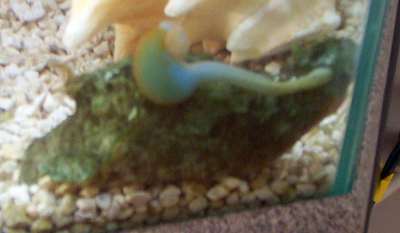
Hi - I just found this forum and it's great. I'm hoping someone can help me out.
I bought a sea hare at the local fish store last week. I think it's a Dolabella auricularia, based on the info I found here. He/she was doing great, eating, cruising around. But today I noticed that part of what look like its innards are now outards. I don't know if this is normal or if something's gone terribly wrong.
If you look at the pic, it's the tube with the kidney shape at the end. It's coming out of the side of its 'head'. It's still moving around, so I guess that's a good sign. Any ideas? Is it normal?
Brian Vastag
brianvastag@comcast.net
Vastag, B., 2005 (Jul 18) Is my sea hare sick?. [Message in] Sea Slug Forum. Australian Museum, Sydney. Available from http://www.seaslugforum.net/find/14278Dear Brian,
I am not sure of the species from your photo but the structure you are worried about is its penis. I suspect it is 'sick' because they don't normally walk around with it displayed like this. Often when they are not well the buccal bulb, the muscular organ containing the radular teeth, will pop out through the mouth, which is a sure sign the animal will die in a few hours.
Having a penis doesn't make it a 'he' it is still a he/she, all opisthobranch sea slugs being both male and female. Concerning keeping this animal alive in an aquaria. If it survives the present peculiarity, there is a chance it will survive. Sea hares feed on particular sea weeds, which are not a good thing to put in aquaria because many of them, particularly browns and reds, give off many toxic chemicals. Some poeple have had success feeding them with garden lettuce which is dunked in boiling water for a second or so and then put in the aquarium. Experiment with small pieces.
Best wishes,
Bill Rudman
Dolabella auricularia from Sth Korea
July 18, 2005
From: Dong Bum Koh
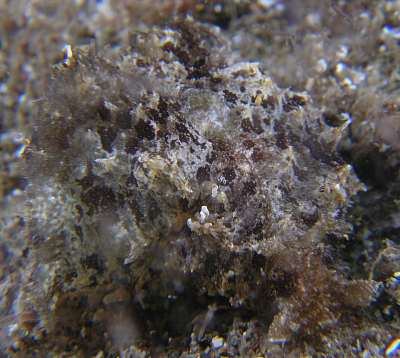
Dear Bill,
Here are some photos of Dolabella auricularia (Lightfoot, 1786) for the Forum.
Locality: Hwa Soon, Jeju Island, Sth Korea Depth: 4 m. Length: 50 mm. 12 Dec. 2004. Sandy bottom with Rock Wall. Photographer: Youn Byung Ro
The uppermost photo is a anterior view & the lowermost photo is a closeup of posterior view of the animal. We can see the central hole (= exhalent siphon) in center of the lower photo. Compare this animal with my prior message (#7352: size about270 mm), its size, color, shape... are different.
After take some live photos, I sampled it and dissected the animal and extracted the hidden shell as shown in the middle photos.
Best regards,
Dong Bum Koh
drkoh@seasee.co.kr
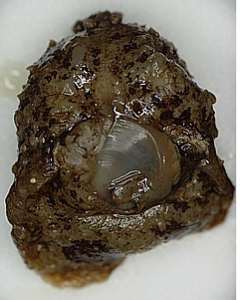
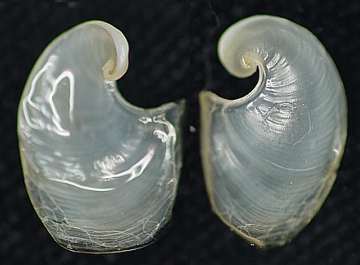

Dear Koh,
Thanks for these photos which show the shape and position of the shell very well. This species is quite varaible in colour and as your show, is very well camouflaged in its normal environment. I can't say I have seen one with yellow-tipped papillae before.
Best wishes,
Bill Rudman
Dolabella auricularia from Natal
June 6, 2005
From: Gerda du Raan
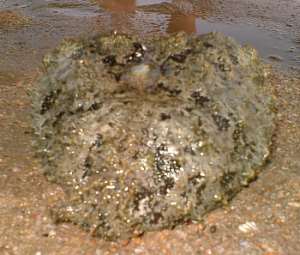
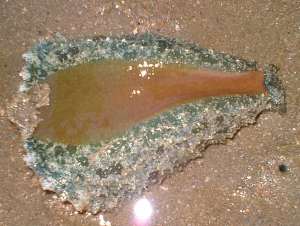
Hallo, can you tell me if this is a sea slug ?
Locality: Uvongo beach, Natal. South Africa. Depth: 300 mm. Length: 250 mm. 30 May 2005. muddy. Photographer: Gerda du Raan
Thanks,
Gerda du Raan
pinkpanther4@absamail.co.za
du Raan, G., 2005 (Jun 6) Dolabella auricularia from Natal. [Message in] Sea Slug Forum. Australian Museum, Sydney. Available from http://www.seaslugforum.net/find/13969Dear Gerda,
This is the Sea Hare, Dolabella auricularia. It is not the prettiest of sea slugs, and looks even worse, like this, when it is out of water. The brown stripe in your lower photo, showing the underside of the animal, is the muscular sole of the foot. Have a look at the Fact Sheet and the other messages attached to that page for more information on the species.
Best wishes,
Bill Rudman
Dolabella auricularia in aquarium
February 8, 2005
From: Tomoko Schum
Hi,
I am in the process of moving my tank inhabitants from an established 29 gallon tank to a newly cycled tank. One of the inhabitant is Dolabella auricularia. I am wondering how to acclimate it to the newly cycled tank. I heard that some sea slugs are somewhat sensitive and they need to be carefully acclimated. Does Dolabella auricularia need a well established tank to thrive? Should I even attempt to move it into the new tank. He is about 6 to 7 centimeters long and eats a large amount of macroalgae (Dictyota sp.) The new tank is full of hair algae right now, but it does not have the Dictyota. The food is not a problem since I can supply a plenty of dictyota out of my refugium if it chooses not to eat Bryopsis or Derbesia. I am rather attached to my Dolabella now that I had him for a while. Your advice will be greatly appreciated.
Tomoko Schum
tomokoschum@knology.net
Schum, T., 2005 (Feb 8) Dolabella auricularia in aquarium. [Message in] Sea Slug Forum. Australian Museum, Sydney. Available from http://www.seaslugforum.net/find/13073Dear Tomoko,
I would think if the water chemistry is ok the Dolabella should be ok in your new tank. It is one Sea Hare which seems to eat quite a variety of algae so it might be worth seeing if it will eat the various hair algae in your new tank. If not I guess you will have to put some Dictyota in. Although Dolabella are not the most beautiful of sea slugs, I agree that they have a certain charm. I would be interested in a progress report.
Good Luck,
Bill Rudman
Sea Hare from Hawaii
December 23, 2004
From: Lyudmila Zinkova
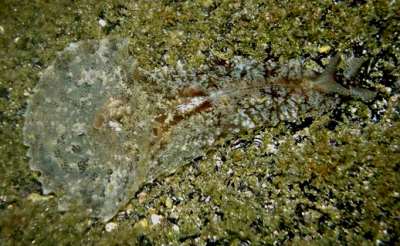
Hello, Bill,
I took that picture in Kona, Hawaii. Do you know what sea hare it is?
Thank you
Mila.
MBZ1@pge.com
Zinkova, L. , 2004 (Dec 23) Sea Hare from Hawaii . [Message in] Sea Slug Forum. Australian Museum, Sydney. Available from http://www.seaslugforum.net/find/12652Dear Lyudmila,
This is Dolabella auricularia.
Best wishes
Bill
Rudman, W.B., 2004 (Dec 23). Comment on Sea Hare from Hawaii by Lyudmila Zinkova . [Message in] Sea Slug Forum. Australian Museum, Sydney. Available from http://www.seaslugforum.net/find/12652
Dolabella auricularia from Sydney Harbour
August 11, 2004
From: Greg Braun
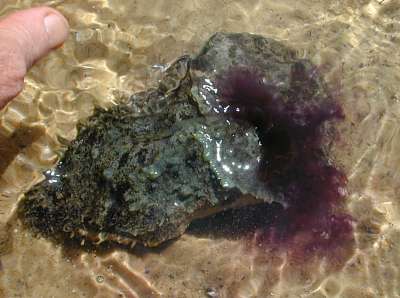
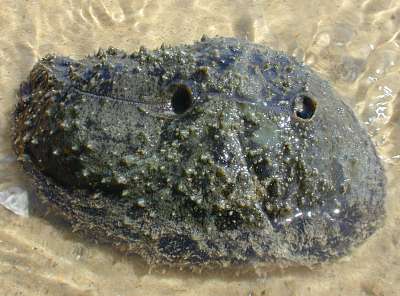
Please tell me what this is
Photographed in Middle Harbour, Sydney. Mid summer 04. Three 'slugs'. A sandy beach at water edge. One individual 3 meters above water line on sand
Slug like, 150 mm long x 90 mm across.
One individual discharged a plume of magenta into the water.
Thanks
Greg Braun
gregb@mrbamboo.com.au
Braun, G., 2004 (Aug 11) Dolabella auricularia from Sydney Harbour. [Message in] Sea Slug Forum. Australian Museum, Sydney. Available from http://www.seaslugforum.net/find/12626Dear Greg,
This is a Sea Hare called Dolabella auricularia. Most Sea Hares produce a red or purplish ink like this.
The two holes you can see in the lower photo are the inhalent and exhalent siphons which are used to move water in and out of the mantle cavity which contains, among other things, the gill which is used for breathing.
Best wishes
Bill Rudman
Re: Sea Hares
February 4, 2004
From: Tom and Jack Burrows
Dear Bill
Thank you for your answer and pictures. Sea Hares were what we found. we live in Maianbar in Sydney, [New South Wales, Australia] in the Royal National Park, and we found them out the front of our house. The Sea Hares were really slimy, maybe I have discovered a new species, because mine were huge.
Thanks,
Tom Burrows
glinda@dodo.com.au
Burrows, T.& J., 2004 (Feb 4) Re: Sea Hares. [Message in] Sea Slug Forum. Australian Museum, Sydney. Available from http://www.seaslugforum.net/find/12115Sea slugs?
February 3, 2004
From: Tom and Jack Burrows
Yesterday my brother and I we playing on the beach near a deep pool of water. we found these long fat slug things, that were covered in grreen slimey stuff. They had heads like snails, with those antena things on there head. they were about 25cm long and fat, wen you turned it over, it had like a snail foot. They had weird holes on their back, which they sucked and blew water out of. I am trying to find a picture of one, but I don't know the big names at the start of your species list, so I don't know what to look up. The 4 slugs we caught, when we put them back, all followed each other in a line. they were also blowing ink out of them. What are they?
Thanks
Tom and Jack Burrows
(8 and 5 years old)
glinda@dodo.com.au
Dear Tom & Jack,
You don't say where in the world you saw these animals but from your email address I guess it's somewhere in Australia.
When I was about halfway through your excellent description I was pretty sure you had found a Sea Hare called Dolabella auricularia. Your mention of them blowing ink pretty much confirmed my feeling. Have a look at the Sea Hares Page for some general information and have a look at the Dolabella auricularia Fact Sheet for information on your animal. If you look at the other messages attached below your message on the page you will find photos and information from all round the works on this animal.
Some people think that like the octopus, the ink they produce is for defence, but there is no evidence for that. The ink is probably just a waste product they produce when they eat red sea weeds. [Have a look at the Purple Ink Page ].
The two holes you saw which sucked water in and out are called siphons. Their job is to suck water in and out of a cavity inside their bodies which contains their flattened shell and their gill which they use for breathing. Without the siphons keeping a fresh supply of sea water coming in and out of the cavity they would not be able to use their gill for breathing. There is a separate page where you can see photos of their shell.
Best wishes
Bill Rudman
Dolabella auricularia from Red Sea
January 22, 2004
From: Isabelle Drouet
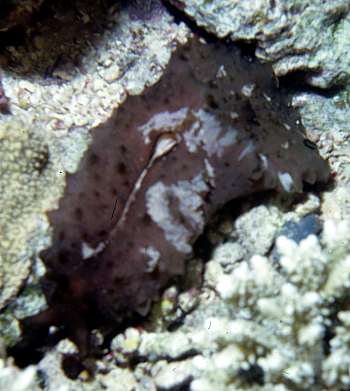
Dear Bill,
This is from Sharm El Sheik, Red Sea [Egypt]. Is it Dolabella auricularia ?
Thanks,
Isabelle Drouet
ijdrouet@free.fr
Drouet, I., 2004 (Jan 22) Dolabella auricularia from Red Sea. [Message in] Sea Slug Forum. Australian Museum, Sydney. Available from http://www.seaslugforum.net/find/11978Dear Isabelle,
Yes I am pretty sure this is Dolabella auricularia. This grey and brown colour form is not as common as the green and brown form but I guess it is a question of camouflage. The long tapering papillae are typical of this species.
Best wishes
Bill Rudman
Suitability of Dolabella auricularia in an aquarium
December 6, 2003
From: Carolyn Bryce
Hi
I have come upon your excellent website after trying to find information on Dolabella auricularia. I have been offered one of these animals for my marine aquarium to deal with nuisance algae including bryopsis, feather caleurpa, bubble algae and some hair algae. Does this species feed on these algae as obviously I don't want to add it for it to starve plus if it doesn't eat these types of algae the it would be a waste of time adding it in the first place! The tank contains mainly SPS corals and a deep sand bed of about 4 inches.
Any help you could give me on this animals diet would be greatly appreciated and congratulations on you excellent and informative site.
cheers
Carolyn Bryce
c.bryce@strath.ac.uk
Bryce, C., 2003 (Dec 6) Suitability of Dolabella auricularia in an aquarium. [Message in] Sea Slug Forum. Australian Museum, Sydney. Available from http://www.seaslugforum.net/find/11612Dear Carolyn,
I guess the first thing to realise that as in nature, there is seldom an easy answer to pest control. If you introduce something and it gets rid of all your pests what them does it eat until the pests return? Sea Hares, such as Dolabella, sometimes work quite well in solving algal problems in aquaria so it's worth try. Dolabella is a species which seesm to prefer a variety of algal species in its diet, but I don't know whether it will eat species of Caulerpa which have some particular nasty defensive chemicals. So unless it's a large animal [more than 6 cms] it's probably worth giving it ago. The reason I say avoid large animals is that they may be nearing old age and natural death and they would require quite a lot of food.
Good luck
Bill Rudman
Inking behavior in Dolabella auricularia
October 3, 2003
From: Jaron Brown
Dear Bill
I am an undergraduate student at BYU-Hawaii on the island of Oahu and am working an establishing an LD 50 for Dolabella auricularia ink. I am however having problems with the sea hares producig ink once they've been in captivity for a few weeks. I was wondering if you have an information on why this may be the case and what to do about it.
I really enjoy your site by the way.
Mahalo!
Jaron
jaronbrown79@hotmail.com
Brown, J., 2003 (Oct 3) Inking behavior in Dolabella auricularia. [Message in] Sea Slug Forum. Australian Museum, Sydney. Available from http://www.seaslugforum.net/find/11090Dear Jaron,
In general, Sea Hares need to eat red algae to produce purple ink, as that is where the colour pigment comes from. I don't know what you are feediing your sea hares, but if you haven't got any red algae in the diet I doubt if they will produce purple ink for you. See the Fact Sheet on the species for further links and references on feeding and biology.
Concerning the ink. If you haven't already done so, look at the Purple Ink Page where you will see there is considerable doubt about whether the ink is a defensive secretion at all. I would assume that if you are trying to establish an LD 50, you are making the assumption that the purple ink is a poisonous substance with a possible defensive purpose.
[Note: To those of you who don't know what LD 50 means, it is shorthand for Lethal Death 50% and is used as a measure of toxicity. The LD 50 of a substance is the concentration that will kill 50% of a sample population].
Just because a substance is poisonous does not mean that its primary function is to kill things. It's possible that an animal kept in a solution containing purple ink would die, but there are many excretory products I would prefer not to be immersed in. It does not mean they have a defensive function however. It is an interesting topic so please keep us informed of your activities and results
Best wishes
Bill Rudman
Dolabella auricularia in the South China Sea
April 17, 2003
From: Kheong San Chang


Dear Bill,
Can you tell me what this big animal is? Saw him in about 7m of water on the night dive from the shore at Layang Layang, 27 March. He is about a foot long and quite ugly. It is difficult to see details from the photo, but he also had a kind of spout on his back. similar to a nudi's gills, but looked just like a tube.
[300 km northwest of Sabah's capital Kota Kinabalu in the South China Sea, Layang Layang, known as Swallows Reef]
Kheong.
kschan@mail.dsi.nus.edu.sg
Chang, K.S., 2003 (Apr 17) Dolabella auricularia in the South China Sea. [Message in] Sea Slug Forum. Australian Museum, Sydney. Available from http://www.seaslugforum.net/find/9639Dear Kheong,
This is the Sea Hare Dolabella auricularia. They are not the most beautiful sea slug and do grow to quite a large size. If you look at the Fact Sheet, and other messages on this page you will find quite a bit of information on this animal. It differs from most species of Aplysia in having very small parapodia whih tightly enclose the mantle cavity in which the gill sits. The tube or spout you mention is the exhalent water siphon which expels water out of the mantle cavity. It is also the way faeces are removed from the anus. At the front of the mantle cavity the edge of the parapodia fold to form an inhalent siphon forming a funnel for water to enter the mantle cavity.
Best wishes,
Bill Rudman
Re: Dolabella - Captive breeding
March 31, 2003
From: Cathryn Clarke
Hi Bill,
I am a Masters student at James Cook University [Townsville, Queesnland]working on sea hare feeding. Part of my project involves rearing the larvae of Dolabella auricularia. In response to the recent message posted, there is a single reference where Dolabella has been successfully raised in laboratory culture.
• Switzer-Dunlap, M. & M.G. Hadfield. 1977. Observations on development, larval growth, and metamorphosis of four species of Aplysiidae (Gastropoda: Opisthobranchia) in laboratory culture. Journal of Experimental Marine Biology and Ecology, 29: 245-261.
I have found that the most important issues to address are finding an appropriate food source for the planktonic larvae and a means of keeping the veliger larvae from becoming trapped in the surface tension of the water. Hope this helps.
PS. Thank you for the website, it has proved invaluable in my studies!
Sincerely,
Cathryn Clarke
Cathryn.Clarke@jcu.edu.au
Thanks Cathryn,
I look forward to hearing of and reading your results - hopefully not too far into the future. As you have discovered, culturing the appropriate phytoplankton for food, and preventing the larvae from getting trapped in the surface tension are indeed the two areas of greatest heartbreak in culturing mollusc larvae.
Best wishes,
Bill Rudman
Dolabella auricularia captive breeding
March 29, 2003
From: Hervé
Hi,
I'm a French reef aquarist and I'm looking for some references about Captive breeding of Dolabella auricularia ... I have looked at previous posts but didn't find anything ... I know that spawning events are relatively common but I don't know if larvae can be bred and how ??
Thanks a lot !
Hervé
herve@aquarium-recifal.net
Hervé, 2003 (Mar 29) Dolabella auricularia captive breeding. [Message in] Sea Slug Forum. Australian Museum, Sydney. Available from http://www.seaslugforum.net/find/9492Dear Hervé,
I guess you looked at the Dolabella references page. There are a couple of references there on larval development. I don't know of anyone who has kept and bred Dolabella in captivity. That is not to say that it has not been done, just I don't know of any published account of it. Certainly the related Aplysia californica is bred commercially in Florida, in large numbers, so theoretically it should be possible to do the same with Dolabella. One question you would need to answer is whether they have planktonic larvae and if so, whether it feeds in the plankton. Assuming they do, then the big problem in either small-scale or large-scale breeding, is keeping the planktonic larvae alive, well-fed, and healthy.
Best wishes,
Bill Rudman,
Dolabella auricularia from the Philippines
February 6, 2003
From: Anevi Gunday
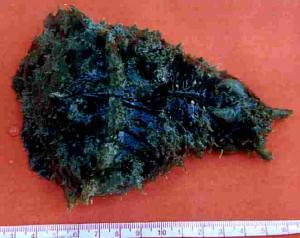
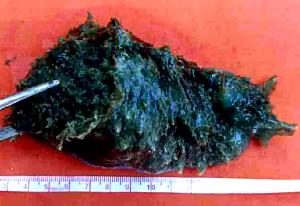
Hi Sir,
I'm an avid reader of your Forum, and I've got a lot of information about sea hares from it. By the way, I'm from Philippines and currently studying the sea hare in Sarangani Bay - at southern tip of the Philippines. It was collected in a part of the intertidal zone, which had a variety of sea grasses, alage and some invertebrates such as shelled molluscs, brittle stars, holuthorians, sea urchins. I have tentatively identified it as Dolabella auricularia but I need a confirmation from an expert in this field. Hope that you can help me.
Anevi Gunday
anhy_jamm@yahoo.com
Gunday, A., 2003 (Feb 6) Dolabella auricularia from the Philippines. [Message in] Sea Slug Forum. Australian Museum, Sydney. Available from http://www.seaslugforum.net/find/8069Dear Anevi,
Good Luck with your research project. Yes your animal is definitely Dolabella auricularia. The flattened, sloping back, which hides the large flat shell, can easily be seen in your lower photo.
Best wishes,
Bill Rudman
Dolabella auricularia from Lord Howe Island
January 30, 2003
From: W.B. Rudman
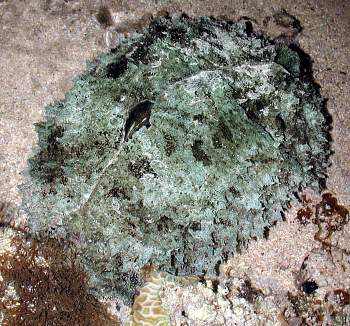
Here is a photo record from Ian Hutton of Dolabella auricularia from Lord Howe Island.
Location: South Reef.
Bill Rudman
Rudman, W.B., 2003 (Jan 30) Dolabella auricularia from Lord Howe Island. [Message in] Sea Slug Forum. Australian Museum, Sydney. Available from http://www.seaslugforum.net/find/8954Dolabella auricularia and egg masses
January 14, 2003
From: Rachel Przeslawski
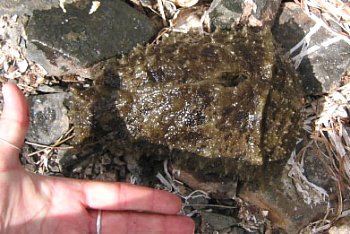
Hi Bill,
I'm pretty sure this aplysiid is Dolabella auricularia, but I thought I'd doublecheck to make sure!
Quite a few of the adults and egg masses were found in an estuarine seagrass bed. The adults were large with 2 prominent siphons and a flattened posterior end. The eggs were in a large brown tangled mass similar to other aplysiids except these masses were much larger than any I'd ever seen. In addition, the egg masses easily untangled from the surrounding seaweed and from each other so that an extremely long thin ribbon could be "unwoven". The biggest difference I found between these egg masses and those of other SE Australian aplysiids was that there were only 1-5 embryos per capsule. Indeed, some egg masses had only 1-2 embryos per capsule.
Rachel Przeslawski
rachelp@uow.edu.au
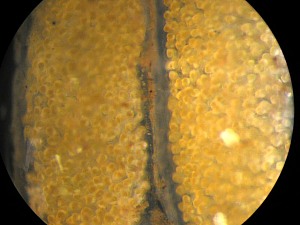

Thanks Rachel,
From your email address, can I assume your animals were from Wollongong, [New South Wales, Australia]? If you have a higher resolution scan of the whole egg mass it would be nice addition to the Forum. Your animal is indeed Dolabella auricularia. Concerning the number of eggs per capsule, this seems to differ quite markedly in different species. Thompson (1976) reports that in British species, Aplysia depilans averages 25eggs per capsule, Aplysia fasciata approximately 43 eggs, and Aplysia punctata as few as 4.
Best wishes,
Bill Rudman
Re: Growth stages in Dolabella auricularia
January 4, 2003
From: Alicia Hermosillo
Dear Bill,
I did find quite a few like the one in the unknown pictures that one time, but have not seen them again since. They were all very small and that is why the picture is not as clear as one would hope. I did not see it swiming, but it was living among alga instead of under rocks. The smallest Dolabella auricularia I have seen so far was well over 8 cm, so all these guys beeing so tiny it did not cross my mind it could be Dolabella. I would also leave it in the Dolabella page and let´s wait and see if I find some more like it this next summer.
Ali
gueri25@hotmail.com
Hermosillo, A., 2003 (Jan 4) Re: Growth stages in Dolabella auricularia. [Message in] Sea Slug Forum. Australian Museum, Sydney. Available from http://www.seaslugforum.net/find/8814Thanks Ali,
Good idea. If you do find them again, check if the parapodia are free like an Aplysia or joined. If joined, see if there are 2 openings or one and whether it swims if disturbed.
Bill Rudman
Re: Growth stages in Dolabella auricularia
January 2, 2003
From: Alicia Hermosillo
Dear Bill,
I was looking at Mary Jane´s pictures of growth stages of Dolabella auricularia. Please compare her number 3 image with my unknown Aplysiid. Would you say that is what my unknown species is? May be I have solved one unidentified..
Cheers and a happy branching New Year!!!
Ali
gueri25@hotmail.com
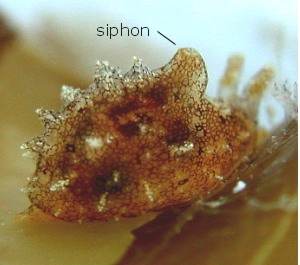
Dear Ali,
Thanks for the New Year greetngs and thanks for thinking about the 'unidentified'. I had assumed from your photos that your animal had two Aplysia-like parapodia, but on having a second look it seems the parapodial cavity is closed except for an anterior siphon? I have copied one of your photos alongside. If this is so, then I wouldn't be surprised if your animal - and probably Mary Jane's - is Notarchus rather than Dolabella. I will have to check through my field notes but I am pretty sure the flattened disc at the back of Dolabella is quite obvious in small juveniles, which is rather different from both your animal and Mary Jane's. One noticeable feature of Notarchus is its spectacular swimming behaviour, where it squirts water out of its single siphon to 'jet' around in a tumbling motion. Did you see any indication of that?
Thanks for drawing your 'unidentified' to my attention, and making me have a second look at Mary Jane's photos. I'll move your animal temporarily to the Dolabella page until I hear from you, but I am pretty sure Notarchus is a better id. You mention they were quite common. Did they grow any bigger?
Best wishes,
Bill Rudman
Re: Dolabella juveniles
January 2, 2003
From: Mary Jane Adams

Happy New Year Bill,
Concerning Alicia's message. Here is the only other image I have of the 12mm sea hares I previously posted. I thought the rear ends of these had the distinctive "cut off" look of more mature Dolabella. None of them exhibited any swimming motion. Tekat Larry, Lembeh Strait, Sulawesi Island,
Indonesia. Nov. 19, 2002.
Best regards,
Mary Jane
divepng@yahoo.com
Adams, M.J., 2003 (Jan 2) Re: Dolabella juveniles. [Message in] Sea Slug Forum. Australian Museum, Sydney. Available from http://www.seaslugforum.net/find/8772Thanks Mary Jane,
From this dorsal photo I agree that they are almost certainly juvenile Dolabella. They are obviously crawling along on a very broad foot, while in Notarchus the foot is very narrow, and in the bottom right animal, the brown line seems to indicate the parapodial slit between the separate inhalent and exhalent siphons found in Dolabella. I don't know if that means Alicia's animal is also Dolabella. Perhaps the pointed tubercles with white cores, which make both your animals and Alicia's look so similar, are a common juvenile feature.
Best wishes,
Bill Rudman
Growth stages in Dolabella auricularia
January 1, 2003
From: Mary Jane Adams

Hi Bill,
Here are some images of Dolabella auricularia at various stages of life.
Image 1 is a 2cm specimen I found at Tekat Larry, Lembeh Strait, Sulawesi Island, Indonesia on Nov. 19, 2002. Image 3 is one from an aggregation of baby sea hares I found from the same dive at Tekat Larry, Lembeh Strait, Sulawesi Island, Indonesia on Nov. 19, 2002. It was 12mm long.
Image 2 is another 2cm slug I shot in Lembeh Strait in April, 2002.
Image 4 is the front end of a lumbering, 50cm hulk, that I photographed on a night dive at George's Night Spot, Morovo Lagoon, Solomon Island in November, 2001. They are not very photogenic at this size.
Do these large opisthobranchs live longer than the average size ones?
Best regards,
Mary Jane
divepng@yahoo.com


Dear Mary Jane,
I see in one of the messages on the Life Span Page I say that Dolabella auricularia can live for six years in an aquarium, but I am afraid I didn't include a reference. very remiss of me. We don't know enough about opisthobranch life cycles, but most that have been studied have live for about a year or less. Many small species can complete a life cycle in a few weeks. Most Sea Hares live for about 12 months.
Cheers,
Bill Rudman
Dolabella auricularia in the Philippines
December 5, 2002
From: Jonathan P. Ubaldo
Dear Dr. Rudman,
I am an undergraduate student of the University of the Philippines in the Visayas, Cebu College. I'd like to know what is the best time of the year to collect sea hares, particularly Dolabella auricularia which I will be using for my thesis study. I have an inkling that it is best to collect them during summer when water is warm as what I have read from observations in Australia. But then our waters here in the Philippines, being tropical, stay generally warm throughout the year, so I think I could find them all year round.
What do you think?
Thanks,
Jonathan P. Ubaldo
atanix@eudoramail.com
Dear Jonathon,
Good Luck with your studies. If you look at the Dolabella Reference List there is a publication on the ecology of this species from the Philippines which should give you some background information. From my experience, and of course many published studies by other workers over many years, tropical waters are not dull places with the same thing happening every day. There are indeed cyclical changes, probably triggered by climatic events, such as monsoons, wet seasons, lunar cycles etc, just as spectacular as the seasonal cycles in temperate waters. The classic synchronised coral spawning on the Great Barrier Reef is a perfect example. So I suspect your Sea Hares may not be equally common all year round.
Best wishes,
Bill Rudman
EU survey of Dolabella
September 23, 2002
From: Kim Friedman
Bill,
As part of an EU program assessing subsistence invertebrate fisheries in the Pacific (11 countries) for the next 5 years, I will be looking at Dolabella auricularia a lot - (popular and hardy populations in seagrasses chopped for Kai by locals all around the Pacific). I am sure this doesn't horrify you - but believe it or not these 'sea cats' (FAO term) supply the majority of the daily food needs for some Pacific Islanders in parts of Tonga and Fiji. Do you know where I can access density info or any other useful reports that I could use for contrasting - reporting comparative assessments around the Pacific.
Cheers
Kim
Dr Kim Friedman
Senior Reef Fisheries Scientist (Invertebrates)
Secrétariat de la Communauté du Pacifique (CPS)
Secretariat of the Pacific Community (SPC)
BP D5 - 98848 NOUMEA
Nouvelle-Calédonie
KimF@spc.int
Friedman, K. , 2002 (Sep 23) EU survey of Dolabella. [Message in] Sea Slug Forum. Australian Museum, Sydney. Available from http://www.seaslugforum.net/find/7987Dear Kim,
Finding out that people eat sea slugs doesn't horrify me, but finding out that FAO have invented the 'common name' sea cats does. On more substantial matters, it will be interesting to get some concrete information on who eats Dolabella. I guess you have seen the correspondence on the Sea Slug Forum on this subject. If not have a look at the messages attached on the to the Dolabella page. The only contact I can offer is Dr. Veikila Vuki, University of the South Pacific, Fiji, who had a student Sandeep Singh looking at populations around Fiji. What would be interesting to know is just what parts of the sea hare are eaten, are there many records of food poisoning from badly prepared slugs, do they eat it all year? ie: is the population seasonal or are there constant populations all year etc?
Best wishes,
Bill Rudman
Aplysiid from Bahia de Banderas
September 13, 2002
From: Alicia Hermosillo

Dear Dr. Rudman,
I do not think I have sent these pictures. It is a species I have not identified yet. It was with a brown alga that covers most of the bottom since the water temperature rose this summer.
Picture: 17mm long, 22 feet deep in Islas Marietas, Bahia de Banderas, Pacific Coast of Mexico. July 1st.
Alicia
gueri25@hotmail.com


This is most probably a juvenile of Dolabella auricularia. See Alicia's later message. [Note added 2 Jan 2003]
Dear Ali,
I am pretty sure these are juveniles of a species of Aplysia. If they are juveniles, they will be difficult to identify unless you can watch them grow to adulthood.
Best wishes,
Bill Rudman
About dolastatines
July 6, 2002
From: Denis Berlemont
First: thank you for this very exciting Forum. You know of course that dolastatins are oligopeptids from Dolabella auricularia, and they are used in research on various cancers (solid tumours, liver, leukemias, and other). The synthesis of dolastatine is difficult, with a poor water solubility. A hydrosoluble semi-synthetic analog (Cemadotine) has been developed.
Do you know if Dolabella auricularia is still collected for medical research, and if the answer is "yes" where are they collected? Is it possible to grow them by aquaculture, and would collecting them damage the ecosystem?
Thanks
Denis Berlemont M.D.
France
Denis.berlemont@wanadoo.fr
Berlemont, D., 2002 (Jul 6) About dolastatines. [Message in] Sea Slug Forum. Australian Museum, Sydney. Available from http://www.seaslugforum.net/find/7430Arnaud Parenty in an earlier message mentioned his research and the interesting discoveries that have been made on dolastatins from Dolabella auricularia. He may be able to give you information on where to obtain specimens, and whether anyone is culturing them like Aplysia californica. I see no reason why they couldn't be grown by aquaculture. You can find more background information and references on the Dolabella auricularia Fact Sheet. if you look at earlier messages you will see that this species is collected for food in some parts of the tropical Pacific. However for research projects artifical culture would be the only way to guarantee a reliable supply of animals
Best wishes,
Bill Rudman
Dolabella auricularia from Sth Korea
June 28, 2002
From: Dong Bum, Koh


Dear,Bill
Here is a photo Dolabella auricularia from Korea for the Forum.
Data
Site: Inner sea near Seogwipo, Cheju Island.
Depth: 4m depth
Date: Feb.2002
Photographer: Dong Bum, Koh
All the best!
From Dong Bum, Koh
drkoh@seasee.co.kr
Koh, D.B., 2002 (Jun 28) Dolabella auricularia from Sth Korea. [Message in] Sea Slug Forum. Australian Museum, Sydney. Available from http://www.seaslugforum.net/find/7352Dear Dong Bum,
Thanks for these photos. For those of you not familar with the anatomy of Dolabella, the lower photo is a closeup of the flattened 'posterior shield' of the animal. The central hole is the exhalent siphon which directs water out of the mantle cavity and gill which lies under the shell which is a large flattened plate just under the skin. Have a look at the aplysiid shell page to see what the shell looks like.
Best wishes,
Bill Rudman
Natural history of Dolabella auricularia
March 5, 2002
From: Sheena
I am doing a research project on the California Sea Hare. I need to know about the growth and development of Dolabella auricularia. Can you give me some information?
Thanks,
Sheena.
sparkle_sheenie_1606@yahoo.com
Sheena, 2002 (Mar 5) Natural history of Dolabella auricularia. [Message in] Sea Slug Forum. Australian Museum, Sydney. Available from http://www.seaslugforum.net/find/6369Dear Sheena,
Since it's your research project not mine, I'll point you in the right direction. You may not realise that the Forum is more than just a question and answer list. Your message has been placed on a page where you will find a Fact Sheet on Dolabella auricularia and a series of earlier messages and discussion on the species. You will also find links to a page of references on the natural history of the species. You don't say whether you are at school or university so I am not sure how easy it will be for you to access some of the references but most are in fairly mainstream journals.
Also have a look at the Sea Hares page for some general information on Dolabella's relatives.
Best wishes,
Bill Rudman
Dolabella auricularia from Japan
November 5, 2001
From: Nishina Masayoshi

Dear Dr.Rudman,
I thought this was a stone. It is a very cute animal.
Date: 7 Oct, 2001
Location: Jogashima, (Top of Miura Peninsula), Japan
Depth: 3m
Length: 200mm
Best Regards,
Nishina Masayoshi
nishina@wips.co.jp


Dear Nishina,
They are not the most beautiful of sea slugs, but they are the closest the opisthobranchs get to having a cuddly furry alternative to pandas and koalas. For those of you uncertain of what you are looking at, Dolabella is a type of Sea Hare which is sometimes very common in tropical waters. here are some short explanatory notes on Nishina's photos:
Upper right: side view with head to the right. Lower left: Underside showing head (at top) and smooth yellowish sole of foot. Lower right: Anterior view - the hole at top of the photo is the inhalent pore into the mantle cavity. The line running from the hole towards the front of the animal is the sperm groove which carries the sperm from the genital opening inside the mantle cavity, to the penis which opens on the right side of the head, alongside the mouth.
Best wishes,
Bill Rudman
Where can we find Dolabella
September 15, 2001
From: T. Thiru
I need some Dolabella .... where can I import them from?
T. Thiru
Recifariume@wanadoo.fr
Thiru, T., 2001 (Sep 15) Where can we find Dolabella. [Message in] Sea Slug Forum. Australian Museum, Sydney. Available from http://www.seaslugforum.net/find/5238Perhaps if you gave us a little information it would help. Do you need them alive? or preserved? Are you planning a research project? etc etc
best wishes,
Bill Rudman
Chemical defense in Dolabella
April 8, 2001
From: Julia Brooke
Dear Dr. Rudman:
I am doing a short research paper on the antitumor properties of compounds found in marine organisms. I would like to know how Dolabella auricularia defends itself from predators. Does it use chemical protection, and if so are these chemicals related to the compounds concentrated in its digestive system?
Additionally, I am interested in how those chemicals are acquired. What does Dolabella eat?
Sincerely,
Julia
jdurst1@hotmail.com
Brooke, J., 2001 (Apr 8) Chemical defense in Dolabella. [Message in] Sea Slug Forum. Australian Museum, Sydney. Available from http://www.seaslugforum.net/find/4123Dear Julia,
The Forum is much more than just a queston and answer service and obviously for a research paper you will need more detail than I have time to provide. I can say briefly though that Dolabella appears to be a fairly generalist algal feeder.
If you are not familiar with the way the Forum works, you can navigate by using the row of buttons at the top and bottom of each page and by clicking on any underlined word. Have a look at the page on Dolabella auricularia for general information on this animal and scroll down through all the messages, as you will find more information and references there. You will also find there a link to a page of references on the biology of Dolabella.
Dolabella is a Sea Hare so have a look at the Sea Hares Page, which will give you links to pages with references on defence and other relevant topics.
Best wishes,
Bill Rudman
Diet of Dolabella auricularia
March 28, 2001
From: Arnaud Parenty
Hi Bill,
I would like to know if Dolabella auricularia eats the Marine Sponge Axinella sp. or Pseudoaxinella massa.
Thank you
Best Regards
Arnaud
arnaud.parenty@icsn.cnrs-gif.fr
Parenty, A., 2001 (Mar 28) Diet of Dolabella auricularia. [Message in] Sea Slug Forum. Australian Museum, Sydney. Available from http://www.seaslugforum.net/find/4048Dear Arnaud,
Dolabella auricularia, like all Sea Hares, is a herbivore. Dolabella feeds on a variety of algae. Have a look at the Dolabella references page for some relevant literature. It is possible that a bit of sponge could be ingested during feeding, and so sponge spicules could be found in the stomach or faeces, but this is just a case of messy eating rather than a natural diet.
Your very specific question suggests you have discovered some identifiable spicules in its stomach, or a molecule linked to an axinellid sponge?
Best wishes,
Bill Rudman.
Re: Dolabella auricularia and burrowing
March 19, 2001
From: Don Barclay
Hello Bill,
About your question about whether Dolabella auricularia come out of the sand to feed at night, the answer seems to be a qualified "yes." They certainly aren't out in the day time (though I have seen them in the day time in Tonga), but only a fraction of the population will be visible crawling on the surface even at night. This leads me to believe they don't come out every night, or else they come out in shifts and feed at different times.
Since November, I have snorkeled the Kitano Tusitala area of Western Samoa about ten times at night, at most phases of the moon and tide, and I typically see four or five sea hares in a couple hours in the water. If you contrast that with the number you can "dig up" in the same area during the day, it seems to indicate that they probably don't come out to feed every night.
The sea hares that are buried deepest are often in sand that appears compacted, like it hasn't been disturbed for some time. They will be flattened into a disc, and tend to remain flattened unless you punch them off the substrate. Then it only takes a few seconds for them to inflate their bodies and start crawling.
I hope these observations help. I'm sure there must be others who have found this species under similar circumstances (other than the Prosobranch guys, who poke them out of the way without a thought like I always did).
Take care,
Don
n5ols@samoatelco.com
Barclay, D., 2001 (Mar 19) Re: Dolabella auricularia and burrowing. [Message in] Sea Slug Forum. Australian Museum, Sydney. Available from http://www.seaslugforum.net/find/4009Thanks Don,
This is fascinating stuff. Any future ecological study will have to take this third dimension into account when planning how to sample populations. I have had a bit of a look through the scientific literature and can't find any indication that anyone has considered that these animals are deep burrowers.
Best wishes,
Bill Rudman
Dolabella auricularia and burrowing
March 17, 2001
From: Don Barclay
Hi Bill,
I hate to increase the message backlog with an anecdotal report, but at least it won't require any photo manipulation or digging through species descriptions! You may have already received ten comments on sea hares burrowing, nevertheless here is another one...
Most of the Dolabella auricularia that I see in American and Western Samoa are buried, from 20 to 30 cm deep in clean sand, typically. I was in Western Samoa several times in the past few months, and found dozens of D. auricularia while fanning the sand under coral boulders looking for some of the molluscivorous Conus species. They were usually flattened out against the hard substrate, some buried as deep as 40 cm! Interestingly, I never found any of the molluscivorous cones sharing a coral boulder with a sea hare. Some areas were densely populated with D. auricularia, with about one of every three boulders producing one. (Approximately the same proportion yielded either Conus bandanus, C. omaria, C. textile, C. canonicus, or C. striatus.)
It seems the main areas for these burrowers are shallow sand flats (one to two meters deep) with some grass and scattered coral slabs or boulders. They are abundant near shore just west of Apia Harbour (immediately west of Kitano Tusitala hotel), Upolu Island, Western Samoa, and almost as common in the area fronting the Piula Cave Pool, on the east end of the same island. They are not uncommon in the same type areas of American Samoa. I find them most often near the yacht club on the west side of Pago Pago Harbor, and they are also typically buried in 20 to 30 cm of clean sand.
I have found other species covered with sand, but Dolabella auricularia is the only one I've seen that seems to truly burrow in the sand. I wouldn't be surprised if some related species behaved in a similar fashion, though.
Thanks for making the Forum such a valuable resource.
Cheers,
Don
n5ols@samoatelco.com
Barclay, D., 2001 (Mar 17) Dolabella auricularia and burrowing. [Message in] Sea Slug Forum. Australian Museum, Sydney. Available from http://www.seaslugforum.net/find/3985Dear Don,
I'm always happy to receive messages, especially ones with interesting information like this. I would agree that a depth of 30 cm (1 foot) is a sign of burrowing rather than being covered by sand. I don't know of any other rceord of such deep burrowing. I normally wouldn't look below about 10cm for opisthobranchs so its lucky you were hunting for cone shells. It would be interesting to know how long they stay buried. Do they bury during the day and emerge to feed at night?
This is a very interesting observation. It certainly means that a new dimension will need to be added when ecological studies are conducted on these animals. Has anyone else seen this or something similar with other Sea Hares?
Best wishes,
Bill Rudman
Dolabella auricularia - source of new drug
February 24, 2001
From: Arnaud Parenty
Hello
It's the first time, I've written to this kind of website. I am doing a Ph D in chemistry in France and I am working on substances extracted from Dolabella auricularia. I want just to say that this Sea Hare is a source for new drugs called dolastatines. These substances discovered by Pettit and coworkers (Pettit, G. 1993; Tetrahedron, Vol 41, p9151) have a great potential to cure cancer.
Actually, two of those products are in clinical trial. For an extensive review about dolastatines, you can read this article:
Current Pharmaceutical Design 1999 Vol 5, N°3, pages 139-162
I hope I have contributed to your great web site. I am a French diver too. I have sent a photo of Dondice banyulensis separately.
Best regards
Arnaud Parenty
arnaud.parenty@icsn.cnrs-gif.fr
Parenty, A., 2001 (Feb 24) Dolabella auricularia - source of new drug. [Message in] Sea Slug Forum. Australian Museum, Sydney. Available from http://www.seaslugforum.net/find/3859Dear Arnaud,
Welcome to the Forum, and thanks for the information on Dolabella.
Bill Rudman
Re: Sea Hare eggs
October 14, 2000
From: Nerissa Bontia
Hi Bill
Sorry, my computer was shut down for technical problem. This was the reason
why i was not able to send my thanks to you for replying my query.
Again, I looked at the Sea Slug Forum but i could not really find any information regarding the sea hare egg mass toxicity. I also want to know if there eggs contains toxic as their body does. Also i am interested on the nutrients found in the egg.
I would appreciate much if you could suggest any person who work on these. I am on the way of my research. I need some literature that will fit to my study. So, please help me.
Thank you so much for you time.
Best wishes,
Nerissa Bontia
poner@irepublic.com.ph
Bontia, N., 2000 (Oct 14) Re: Sea Hare eggs. [Message in] Sea Slug Forum. Australian Museum, Sydney. Available from http://www.seaslugforum.net/find/3172Dear Nerissa,
Have you had a look at Kirtsen's message? Apart from that I can't really help. Hopefully someone reading the Forum will be able to give you more advice but I suspect to find answers to your main point about the nutrient value of Sea Hare Eggs you would need to do some chemical analyses yourself.
Best wishes,
Bill Rudman.
Dolabella auricularia from Solomon Ids
October 13, 2000
From: Bruce Potter


Bill,
I was diving in the Russell group of the Solomon Islands last weekend, and on a site known as East Mane, I found a slug I have been looking for for years. It was a Dolabella auricularia.
The odd thing about this find was that it was nine meters down a shear wall. At one stage as it was moving about, it's disproportionate rear end fell of the wall, and it was only saved from falling by holding on by its front end. I have always understood that it inhabits flat sites.
It was quite large at about 45-50 cm. There was plenty of algae and green stuff on the site.
Bruce Potter.
bruce.potter@adventist.org.sb
Potter, B., 2000 (Oct 13) Dolabella auricularia from Solomon Ids. [Message in] Sea Slug Forum. Australian Museum, Sydney. Available from http://www.seaslugforum.net/find/3159Dear Bruce,
The only rule of thumb about where sea slugs are likely to occur is that if their food is there there is always a chance. Dolabella are hardly the most graceful of animals and as you describe are often caught off balance. I have even found Bursatella leachi which is usually found on flat sandy or muddy bottoms, crawling over rocky regions, usually after wet weather when ther is a lot of silt settling out of the water.
best wishes,
Bill Rudman.
Aplysiid egg compounds
September 22, 2000
From: Kirsten Benkendorff
Hi Bill,
Following on your reply to Nerissa's question, here is what I know about toxic compounds from Aplysiidae egg masses. It probably doesn't help much in deciding whether Dolabella eggs are toxic but I don't think I would be eating them based on this info - at least without boiling them really well!
The most interesting compound is a lipid, diacyl hexadecylglycerol, which has been isolated from the egg masses of Aplysia kurodai. This compound is known to have laxative properties and is also thought to cause vomitting in people. A range of novel sterols have also been isolated from this species and A. juliana, which are thought to function as defensive substances based on the biological activities of similar sterols.
Antineoplastic and cytolytic glycoproteins have been isolated from the egg masses of A. juliana and A. kurodai. Antitumor activity has also been reported in the egg mass of Dolabella auricularia but the cytolytic factor has not been isolated. It appears to be different from the compounds isolated from the Aplysia spp. but is still likely to be a glycoprotein, which would be destroyed by heating.
A factor capable of agglutinating vertebrate blood cells has been isolated from Aplysia kurodai eggs, which appears to be a protein that decomposes after heating at 60 degrees.
I found a range of small chlorinated compounds in the freeze dried eggs of Aplysia juliana including chloro propene, dichloropropene and di and tri chloro propanone. These compounds are known to have mutagenic and cytotoxic effects. However, these compounds were not present in the freshly extracted egg mass, suggesting that they could have been breakdown products, possibly from the dietary derived chlorinated terpenes that are commonly found in Aplysia adults.
I also found a range of long chained saturated and unsaturated fatty acids in Aplysia egg masses. Most of these are standard compounds that are unlikely to be toxic, although several could not be identified. It is therefore of interest that a range of novel lactonized dihydroxyfatty acids have been isolated fron the skin of Aplysia depilans, which have ichthyotoxic properties.
Cheers,
Kirsten Benkendorff
Coordinator
Marine Bioprospecting Initiative
Departments of Biological Sciences and Chemistry
University of Wollongong, NSW, 2522
kirsten@uow.edu.au
Benkendorff, K., 2000 (Sep 22) Aplysiid egg compounds. [Message in] Sea Slug Forum. Australian Museum, Sydney. Available from http://www.seaslugforum.net/find/3065Thanks Kirsten,
It is indeed surprising they are eaten, but it seems they are a regular part of some people's diets in Fiji and the Philippines. One other interesting point about aplysiid eggs that needs further study is their colour. In my reply to Nerissa's message I mentioned reports of studies showing that egg colour was dependent on the colour of the algae eaten by the adults. I have just noticed Itai Plaut's report that the eggs of Aplysia oculifera change colour during development, which certainly occurs in other opisthobranchs.
Perhaps I should start a page on aplysiid eggs to summarise all this information.
Best wishes,
Bill Rudman.
Sea Hare eggs
September 21, 2000
From: Nerissa Bontia
Dear Bill,
I am researching on the different web sites and I was so happy when I came across into the Sea Slug Forum. I have read the different messages about sea hares but i've got only a little information regarding the sea hare's egg mass. I am a State College Professor, interested to study on the egg mass of the sea hares specifically Dolabella auricularia which is very common in our country [The Philippines].
Many people are eating these eggs rather than the sea hares itself. What nutrients could we get from the egg? If sea hares are toxic what particular part of the body is affected? Is there a possibility that the egg mass will also contain toxin?
I would appreciate much if you could give me some information on this regard.
Very truly yours,
Nerissa Bontia
poner@irepublic.com.ph
Bontia, N., 2000 (Sep 21) Sea Hare eggs. [Message in] Sea Slug Forum. Australian Museum, Sydney. Available from http://www.seaslugforum.net/find/3047Dear Nerissa,
I am afraid all I know about Dolabella eggs and the possible toxicity of the whole animal is what you will find by reading the other messages on this page. You will find them if you look below your message. I am not sure how familiar you are with web pages but if you click on any underlined topic you will go to a relevant page with more information. In fact the most relevant research has been done in the Philippines.
I can add a little more general information on Sea Hare egg masses.
There are not many records of predators eating the eggs. As far as I can find, only some starfish and the nudibranch Favorinus japonicus. It has been suggested that the reason animals avoid the eggs as food is because they contain distasteful chemicals, in particular secondary metabolites that they obtain from their algal food. However there have been few staudies on the topic. Pennings (1994) offered pieces of egg mass of Aplysia juliana and Dolabella auricularia to crabs and fish but they were rejected. Organic extracts from the eggs of Stylocheilus striatus [as Stylocheilus longicauda] deterred feeding in reef fish at normal concentrations, but the eggs surprisingly did not contain the expected secondary metaobolites.
In another study, Pennings & Paul (1993) could find no secondary metabolites in the egg masses of Stylocheilus, Dolabella or Aplysia californica after adults were fed on either natural diets or diets containing secondary metabolites.
What then makes the eggs distasteful? It has been suggested that it is perhaps related to algal pigments. The egg colour of Sea Hares depends on the colour of the algae they are eating. For example when a Sea Hare changes from green to red algae its egg colour will chnage (Carefoot 1967). The seaweed pigment is transferrd to eggs within 48hrs (Chapman & Fox, 1969,) It is still not clear whether algal pigments are making the eggs distasteful or whether the Sea Hares are producing a new chemical.
Kirstern Benkendorff has just completed a Ph.D thesis [University of Wollongong, NSW, Australia] which included research into the egg masses of Sea Hares. Her findings, when published, will add an interesting new chapter to the story. The papers I have cited can be found on the Sea Hares - Chemical Defence Page.
Best wishes,
Bill Rudman.
Re: Dolabella as food
July 23, 1999
From: Claudia Armann
Hi Bill,
I visted your site and read about Dolabella auricularia. I am Research Editor for AQUA Magazine (www.aquamag.com) and we have a regular column about unique seafood that people eat around the world. I think the sea hare would be a great subject for this piece. I have e-mailed some questions about the edibility to Sandeep, the Fijian researcher.
I wanted to ask you in particular about the toxic quality of this animal. You mentioned that there have been some deaths related to eating sea hares and I wanted to know if this involved Dolabella. Can you tell me about the toxicity of this species and what people do to remove the toxins?
Claudia Armann
Research Editor, AQUA Magazine
California
(805) 745-7118
carmann@aquamag.com
Armann, C., 1999 (Jul 23) Re: Dolabella as food. [Message in] Sea Slug Forum. Australian Museum, Sydney. Available from http://www.seaslugforum.net/find/1099Dear Claudia,
I think Sandeep is the best person to approach for answers about its use as food in Fiji. All I know is what is on this page, from Sandeep and Veikila.
Did I actually say there have been deaths? I know of only one case of poisoning involving Dolabella, and that is reported fully in Michael Sorokin's paper (1998) which you will find in the Dolabella Reference List. In that case both patients survived.
In brief, Sea Hares are herbivores and the algae they feed on contain quite toxic chemicals (diterpenes etc) which could potentially be very powerful defence weapons for the Sea Hares. However, the Sea Hares apparently retain these secondary chemical compounds in their digestive gland, which is an internal organ, rather than in their skin, where they could deter predators.
In the one reported case of poisoning, the animal was taken fresh from the reef, rinsed in seawater, but not otherwise cut open or 'cleaned'. At home it was cut into pieces, fried in oil and eaten with other food. Both husband and wife quickly developed vomiting and diarrhoea, limb pain and tingling, but the husband recovered after a couple of days The wife however was hospitalised with more severe symptoms, but recovered after a week or so.
Details are in Sorokin (1988). One aspect that puzzles me is that other villagers said that the Dolabella needs to be cleaned properly but I have no clear idea of how they do this. I thought perhaps they discard the digestive gland but apparently that is eaten as well. I am hoping Sandeep will be able to clarify this for us as her research develops.
I have just posted a message on Pacific Islanders eating Stylocheilus longicauda. In contradiction to what I say above about Dolabella, they clean the Stylocheilus by removing the internal organs. Very puzzling.
Best wishes,
Bill Rudman.
Dolabella auricularia research
June 22, 1999
From: Sandeep K. Singh
HI BILL,
You will remember I am looking at the reproductive biology of Dolabella auricularia, in Fiji. Very little has been done on it. The method I thought that would be appropriate is the gonad index by area. Do you have any suggestions?
Please let me know as soon as possible
Your kind help will be very much appreciated
thanks,
Sandeep
S95008310@student.usp.ac.fj
S.K. Singh, 1999 (Jun 22) Dolabella auricularia research. [Message in] Sea Slug Forum. Australian Museum, Sydney. Available from http://www.seaslugforum.net/find/956Dear Sandeep,
I am not an expert in ecological methodology and do not know of the Gonad Index by Area method that you mention. A couple of papers which have looked at aspects of Sea Hare growth and reproduction which may give you ideas on methodology are:
* Pauly, D; Calumpong, H (1984): Growth, reproduction and mortality of the sea hare Dolabella auricularia (Gastropoda: Aplysiidae) in the Central Visayas, Philippines. Marine Biology 79, 289-293.
* Audesirk, T.E (1979) A field syudy and reproduction in Aplysia californica. Biological Bulletin, 157(3): 407-421.
Whatever method you use, it may be worth measuring the relative abundance of egg masses as well, as it may prove an easier way to predict the size of the Sea Hare populations. However it may be difficult to distinguish Dolabella's egg strings from those of species of Aplysia.
The Pauly paper is quite interesting because it suggests using the techniques employed by fish biologists. What you will have to do is find a method that you and your supervisor are happy with, because day to day problems will arise which can only be solved by people with local knowledge.
Perhaps someone reading this message can give Sandeep more advice?
Good luck,
Bill Rudman
Dolabella egg masses
April 1, 1999
From: Erwin Koehler

Dear Bill,
Here is a photo of the egg-mass (I guess of Dolabella auricularia) from my latest trip to the Philippines. Please excuse the poor quality - the camera didn't work alright. The photo , I saw several of them at this place): Cebu Is., Moalboal housereef, March 1999, 2m depth.
Erwin
E.Koehler@DeutschePost.de
Koehler, E., 1999 (Apr 1) Dolabella egg masses. [Message in] Sea Slug Forum. Australian Museum, Sydney. Available from http://www.seaslugforum.net/find/751Dear Erwin,
Its definitely a Sea Hare egg mass and from the compact nature of it I am pretty sure it is of Dolabella auricularia.
Best wishes,
Bill Rudman.
Re:Dolabella in Fiji - as food etc
March 17, 1999
From: Veikila Vuki
Thank you Bill for all the information on Dolabella. Sandeep was so thrilled and she is now convinced that its now worth studying Dolabella. I have been trying to convince her for two weeks but without success until you replied to our message and sent us all the references.
Fijian women glean for seahare during very low tide (late afternoon), they say that's when they see a lot of them on the mudflat tidal pools. The Dolabella egg mass are also collected and sold with the viscera. The reason why I asked my student to study Dolabella because part of the animal is discarded and it is quite a waste. In some parts of Fiji, the whole animal is eaten.
Women collect whatever they can find and boil them and cut them into pieces and then they are re-boiled in coconut milk. The viscera is eaten raw and marinated in lemon juice. It is usually mixed marinated together with the egg mass.
I have also been talking to a prawn farmer and he said that seahares (Dolabella) is a pest in his pond. He gets thousands and thousands in his pond and he does not know how to get rid of them
Thank you again Bill. We searched yahoo and came across your name and then got into the seahare forum. It is amazing!!
Many thanks
and we will keep you informed.
Veikila
Vuki_V@usp.ac.fj
Vuki, V., 1999 (Mar 17) Re:Dolabella in Fiji - as food etc. [Message in] Sea Slug Forum. Australian Museum, Sydney. Available from http://www.seaslugforum.net/find/687Dear Veikila,
I'm glad to encourage anyone working on Sea Slugs. Thanks for information on Dolabella as food. I'm not squeamish about eating things from the sea and often nibble on the gonads of a sea urchin or pick off a rock oyster when I'm out collecting, but I must admit the acid glands in their skin and the possibility of nasty unincellular algae in the digestive gland have made me leave Sea Hares out of my diet.
Your comments about the Dolabella in the prawn ponds reminded me of the message from the prawn farmer in Queensland who had huge numbers of another Sea Hare, Bursatella, in his ponds. If you get a chance perhaps you should check whether his Sea Hares are Dolabella or Bursatella.
Best wishes,
Bill Rudman.
Re:Dolabella research in Fiji
March 16, 1999
From: Sandeep K. Singh
Hi Bill,
I am so sorry I couldn't reply any earlier coz I went out on a geology field trip. Bill thank you so so so much for your kind help which was very much needed. I wrote to all the people you directed me to and they have been quite a a help. Once again thank you so very much.
Regards from our paradise island
Sandeep
S95008310@student.usp.ac.fj
Dear Sandeep,
Glad the information was useful. I would very much like to know something about the Dolabella fishery in Fiji. Have you any idea how many are collected?, is it seasonal?, how are they prepared for eating. If you have a spare moment any information would be of great interest.
I spent two months in Fiji in 1971..and yes it is a paradise island.
Please keep in touch,
Bill Rudman.
Re: Dolabella in Fiji
March 16, 1999
From: Sandeep K. Singh
hi Bill,
thanks again for your time.
bill at the moment what i know about Dolabella is that it is found on the mudflats during low tides and here in Fiji people collect it and sell it in the markets.
part of the animal is discarded before eating. The Fijian name for it is veata and kavere(egg mass).
this weekend i'll be carrying out a market survey and on monday i'll be actually going out on the field at low tide to find more about this interesting animal
Sandeep
University of the South Pacific
Suva,
Fiji
S95008310@student.usp.ac.fj
Dolabella research in Fiji
March 10, 1999
From: Dr. Veikila Vuki
Dear Bill,
I have a student wanting to do research on the biology of Dolabella in Fiji. She is also interested in the fishery of it. In Fiji, women collect both the egg mass and the animal and sell them at the Suva Market. Will you be able to give me an address of anyone who is working or had done work on Dolabella.
Thank you,
Dr. Veikila Vuki
Marine Studies Programme,.
University of the South Pacific
P.O. Box 1168, Suva, Fiji.
vuki_v@usp.ac.fj
Vuki, V., 1999 (Mar 10) Dolabella research in Fiji. [Message in] Sea Slug Forum. Australian Museum, Sydney. Available from http://www.seaslugforum.net/find/661Dear Veikila,
What an interesting topic. There was some correspondence last year on indigenous people in the northern Pacific eating a "sea slug", and I recalled then about a case in Fiji of someone being poisoned by eating Dolabella (Sorokin, 1988). I would be interested in any information on the fishery in Fiji and how they "clean" the animal before it is eaten. Is the whole animal eaten or is the viscera removed first?
In general terms I would think Dolabella is very similar to other Sea Hares so if your student has a look at the sections in the Forum dealing with Sea Hares (they are listed in the GENERAL TOPICS index) and any species listed in the ORDER ANASPIDEA in the SPECIES LIST, she will find a lot of relevant information and references. I have also prepared a list of papers dealing specifically with Dolabella
Here are a few people whose addresses are available to me who have worked on Dolabella in the last 10 years or so, but as I say above, anyone working on Sea Hares could probably give you good advice.
Michael Sorokin. Dept of Medicine, Western Divisional Hospital. Lautoka.
S.C.Pennings. University of Georgia, Marine Institute, Sapelo Island, Georgia, 31327, USA.
V.J.Paul. Marine Laboratory, Ubiversity of Guam, U.O.G. Station, Mangilao, Gaum 96923, USA. Email: vpaul@uog9.uog.edu
Thomas H. Carefoot, Dept of Zoology, University of British Columbia, Vancouver, British Columbia V6T 2A9, Canada.
Any information you or your student has to share with us would be very welcome,
Best wishes,
Bill Rudman.
